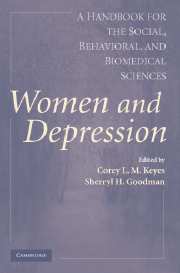Book contents
- Frontmatter
- Contents
- List of Contributors
- Foreword
- Preface
- PART I NOSOLOGY, MEASUREMENT, AND THE EPIDEMIOLOGY OF WOMEN AND DEPRESSION
- PART II BIOLOGICAL, DEVELOPMENTAL, AND AGING MODELS OF RISK
- PART III COGNITIVE, EMOTIONAL, AND INTERPERSONAL MODELS OF RISK
- PART IV SOCIAL, POLITICAL, AND ECONOMIC MODELS OF RISK
- PART V SYSTEMS AND PROCESSES OF TREATMENT, PREVENTION, AND POLICY
- 17 Services and Treatment for Depression
- 18 Prevention of Depression in Women
- 19 Women and Depression
- Author Index
- Subject Index
- References
18 - Prevention of Depression in Women
Published online by Cambridge University Press: 05 June 2012
- Frontmatter
- Contents
- List of Contributors
- Foreword
- Preface
- PART I NOSOLOGY, MEASUREMENT, AND THE EPIDEMIOLOGY OF WOMEN AND DEPRESSION
- PART II BIOLOGICAL, DEVELOPMENTAL, AND AGING MODELS OF RISK
- PART III COGNITIVE, EMOTIONAL, AND INTERPERSONAL MODELS OF RISK
- PART IV SOCIAL, POLITICAL, AND ECONOMIC MODELS OF RISK
- PART V SYSTEMS AND PROCESSES OF TREATMENT, PREVENTION, AND POLICY
- 17 Services and Treatment for Depression
- 18 Prevention of Depression in Women
- 19 Women and Depression
- Author Index
- Subject Index
- References
Summary
THE CASE FOR DEPRESSION PREVENTION IN WOMEN
Depression is currently a major public health problem for women worldwide. Epidemiological data indicate that lifetime prevalence rates of major depressive disorder (MDD) in the United States are 1.7 to 2.7 times greater for women than for men (Burt & Stein, 2002), and rates of MDD have been found to be approximately twice as high among women as men across a range of cultures and countries (Bebbington et al., 1998; Weissman et al., 1996). The negative impact of depression on women is far-reaching. The 2000 census figures estimate the U.S. population at 281,421,906, of whom 143,368,343 (50.9%) are female (U.S. Census Bureau, 2004). Nationally representative data indicate that women have a 21.3% lifetime prevalence of major depressive episodes (MDE; Burt & Stein, 2002), suggesting that over 30 million females will have at least one episode during their lives in the U.S. alone.
Depression produces significant impairments, causing dysfunction that equals or exceeds chronic physical illness (Hays, Wells, Sherbourne, Rogers, & Spritzer, 1995). In addition, researchers underestimate the negative impact of depression when they look only at its direct effects without attending to the concept of attributable risk (Muñoz, 2001), that is, the empirically documented contribution of depression to major causes of preventable death, such as smoking, poor diet and exercise, substance use, firearms, risky sexual behavior, and car accidents (see, e.g., McGinnis & Foege, 1993). Similarly, depression has been linked with higher risk for serious medical conditions.
- Type
- Chapter
- Information
- Women and DepressionA Handbook for the Social, Behavioral, and Biomedical Sciences, pp. 450 - 478Publisher: Cambridge University PressPrint publication year: 2006



